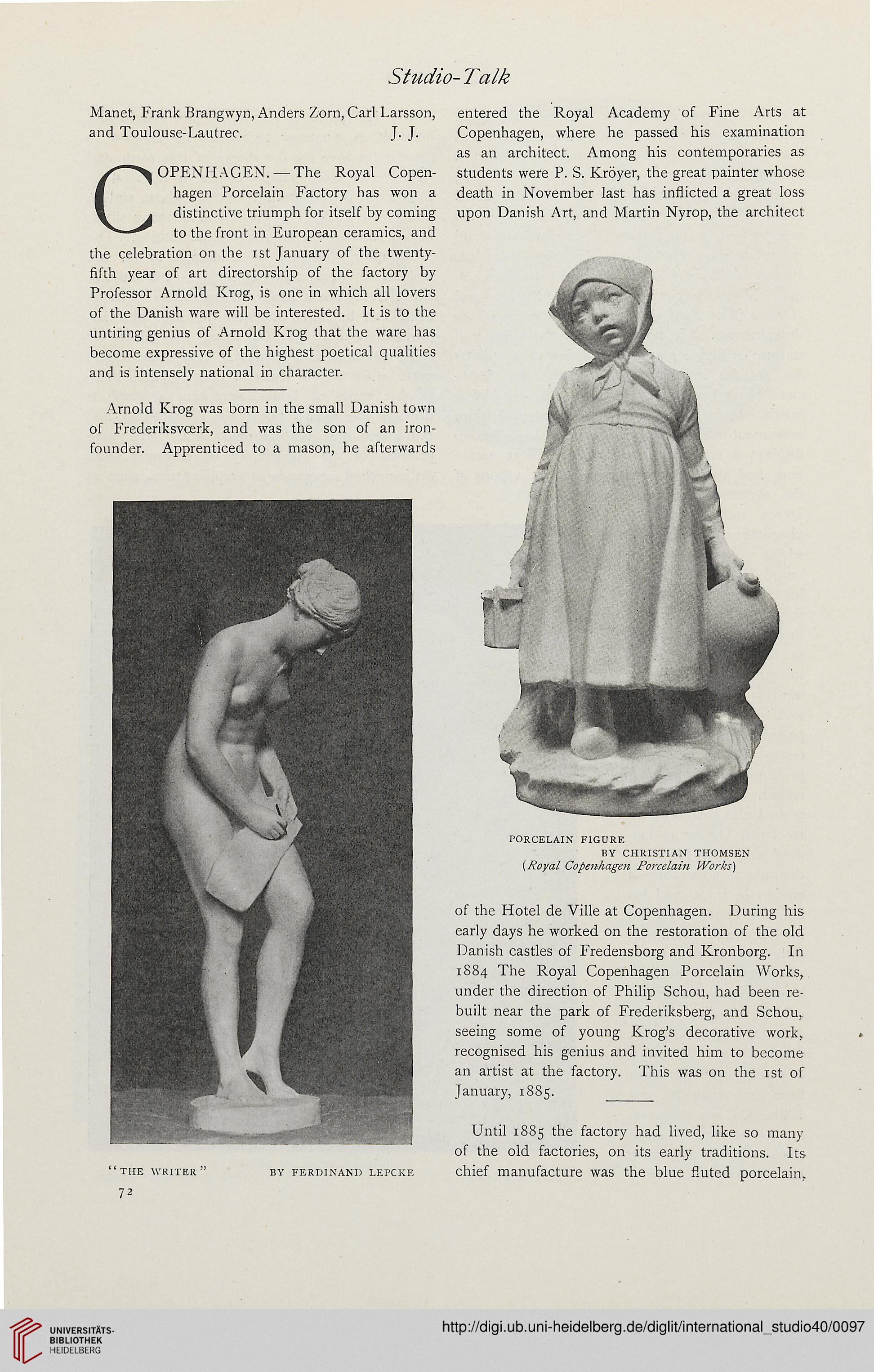Studio-Talk
Manet, Frank Brangwyn, Anders Zorn, Carl Larsson,
and Toulouse-Lautrec J. J.
COPENHAGEN.—The Royal Copen-
hagen Porcelain Factory has won a
distinctive triumph for itself by coming
to the front in European ceramics, and
the celebration on the ist January of the twenty-
fifth year of art directorship of the factory by
Professor Arnold Krog, is one in which all lovers
of the Danish ware will be interested. It is to the
untiring genius of Arnold Krog that the ware has
become expressive of the highest poetical qualities
and is intensely national in character.
Arnold Krog was born in the small Danish town
of Frederiksvcerk, and was the son of an iron-
founder. Apprenticed to a mason, he afterwards
"THE WRITER" BY FERDINAND LEPCKE
72
entered the Royal Academy of Fine Arts at
Copenhagen, where he passed his examination
as an architect. Among his contemporaries as
students were P. S. Kroyer, the great painter whose
death in November last has inflicted a great loss
upon Danish Art, and Martin Nyrop, the architect
PORCELAIN FIGURE
BY CHRISTIAN THOMSEN
(Royal Copenhagen Porcelain Works)
of the Hotel de Ville at Copenhagen. During his
early days he worked on the restoration of the old
Danish castles of Fredensborg and Kronborg. In
1884 The Royal Copenhagen Porcelain Works,
under the direction of Philip Schou, had been re-
built near the park of Frederiksberg, and Schou,
seeing some of young Krog's decorative work,
recognised his genius and invited him to become
an artist at the factory. This was on the ist of
January, 1885.
Until 1885 the factory had lived, like so many
of the old factories, on its early traditions. Its
chief manufacture was the blue fluted porcelain,
Manet, Frank Brangwyn, Anders Zorn, Carl Larsson,
and Toulouse-Lautrec J. J.
COPENHAGEN.—The Royal Copen-
hagen Porcelain Factory has won a
distinctive triumph for itself by coming
to the front in European ceramics, and
the celebration on the ist January of the twenty-
fifth year of art directorship of the factory by
Professor Arnold Krog, is one in which all lovers
of the Danish ware will be interested. It is to the
untiring genius of Arnold Krog that the ware has
become expressive of the highest poetical qualities
and is intensely national in character.
Arnold Krog was born in the small Danish town
of Frederiksvcerk, and was the son of an iron-
founder. Apprenticed to a mason, he afterwards
"THE WRITER" BY FERDINAND LEPCKE
72
entered the Royal Academy of Fine Arts at
Copenhagen, where he passed his examination
as an architect. Among his contemporaries as
students were P. S. Kroyer, the great painter whose
death in November last has inflicted a great loss
upon Danish Art, and Martin Nyrop, the architect
PORCELAIN FIGURE
BY CHRISTIAN THOMSEN
(Royal Copenhagen Porcelain Works)
of the Hotel de Ville at Copenhagen. During his
early days he worked on the restoration of the old
Danish castles of Fredensborg and Kronborg. In
1884 The Royal Copenhagen Porcelain Works,
under the direction of Philip Schou, had been re-
built near the park of Frederiksberg, and Schou,
seeing some of young Krog's decorative work,
recognised his genius and invited him to become
an artist at the factory. This was on the ist of
January, 1885.
Until 1885 the factory had lived, like so many
of the old factories, on its early traditions. Its
chief manufacture was the blue fluted porcelain,




